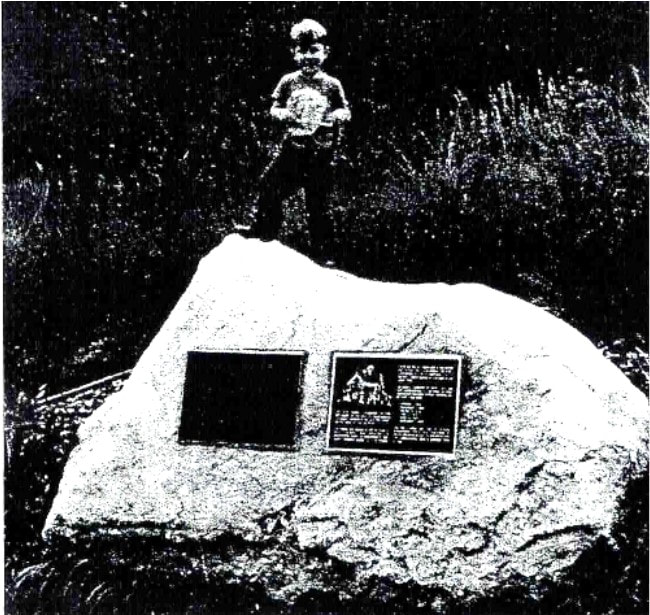This history article comes from one of our newsletters. Newsletters are a benefit of membership with the Hopkins Historical Society. Learn more here: |
The Feltl Rock
by Mary Raabe
first published in 2003, updated in 2020
Our rock is bigger than the Plymouth Rock.
-Stanley Feltl
|
Stanley Feltl might have been right! Plymouth rock looks surprisingly similar to the Feltl Rock.
While not as old or well-known as Plymouth Rock, the impressive Feltl rock has rested proudly on the old Feltl raspberry farm location since 1988. It was placed there to commemorate the 1983 sale of their land to the Opus Corporation. The rock lies just a few steps south of Smetana Road across from the Glenn Senior Living Residence in Hopkins--a reminder of the Feltl family, their trip to America and their contribution to Hopkins/Minnetonka raspberry farming.
Their journey started in 1867 when John Joseph Feltl, his wife Josephine Dvorak Feltl and two children, Anna, age 8, and John Joseph Jr., 5 months, immigrated to American from Czechoslovakia. Mr. Feltl had heard there was good farm land in Minnetonka. The stormy voyage took over seven weeks. The family made it by train from Philadelphia to St. Cloud where they rafted down the Mississippi River to St. Anthony. It rained the entire time, and John Sr. became so ill he was unable to watch the family trunk. The trunk was stolen, leaving them penniless.
The Feltl Family reached the Hopkins/Minnetonka area with the kind help of Joseph Empanger and his oxen and wagon. Overcoming hardship after hardship, they finally settled in Minnetonka close to Hopkins where the old St. Margaret’s Cemetery is located. They lived for a year in a cave with hay over the entrance, surviving on potatoes and cabbage. They sold their only possession, a gun, for three dollars and fifty cents and bought enough wood to build a small farm house. The farm house eventually burned down, and in 1872 they built the Feltl farm house which stood on a hill close to Smetana Road until 1993. Through hard work and endless determination, John Feltl was able was able to buy 75 acres of farm land on either side of Smetana Road. Five children were born to the union of John and Josephine Feltl.
The major challenge to these early settlers was earning a living. John Feltl supported his growing family by picking and selling cranberries that grew wild in the boggy peat soil. After young John turned 11, he was old enough to make the trek to Minneapolis where he also sold cranberries along with firewood and his mother’s lickin’ good butter. In 1893, John married and started a family of his own, living in the same farm house. With his wife’s savings they bought the yellow bricks which were laid on top of the wood frame much like houses are sided today.
In about 1896 their neighbor John Empanger brought raspberries to the area, and he and John Feltl started to grow the bright red berries. John Empanger and John Feltl are considered the “Fathers of Raspberries.”
John Empanger figured out a way to stake the plant so it would grow upright. John Feltl discovered a way to preserve the plants over the winter by furrowing the ground and covering the plants with dirt. Most of the berries were sold at the Minneapolis Farmers’ Market – along with some roadside sales. In the mid-thirties during the severe drought and the depression, it became necessary for the Feltls to discontinue growing the berries. Throughout the 1950s and 1960s some raspberries continued to be grown in Hopkins/Minnetonka area, but the numbers dwindled until no commercial patches remained.
|
The Feltl family continued to live in the farm home growing other fruits and vegetables. Efforts were made to relocate the house but no one had a plan, and finally in 1993 the old house was demolished. The last to live there was Stanley Feltl, son of John Feltl, Jr.
In 1983, the Feltl farm was one of several homesteads purchased by the Opus Corporation to provide land for Opus II Business park. To commemorate the sale of the land, the Feltl Rock was dedicated and placed on October 12, 1988, just 300 feet west of the family farmhouse. The inscription reads “Dedicated to Margaret E. Feltl, farmer and school teacher, whose vision and persistence in preserving the land hereabouts for something other than a solid waste disposable site provide the opportunity to Opus II to become a reality for present and future generations to enjoy.” Several years later, another inscription was added to further recognize the Feltl Family.
The rock represents the long and rich history of the Feltl family’s hard work and benevolence and strong civic leadership. For many years, John Feltl Jr. served on the Minnetonka City Board and the Shady Oak School Association. In the early 1980s the Feltl family donated a portion of their farm land to St. Therese’s for their new senior living residence. Among the many Feltl endowments exists the generous Feltl Family Research Award given annually to the Minnesota Arthritis Foundation.
It is difficult, with all our conveniences, to visualize the average work day on the farms of these early settlers. They met unimaginable challenges with determination and fortitude. We owe so much to these early settlers who paved our way.
The Feltl rock is currently located in the light rail construction zone and cannot be approached. But the next time you drive down Smetana Road take a moment to remember a family who helped carve the history of Hopkins through innovation, perseverance, and responsible stewardship of the land - the Feltl Family legacy.
|
Acknowledgements
Therese Feltl Glatt, former Hopkins Historical Society board member, had contributed to this article. Therese spent many hours recording the Feltl family history. These files are available to read at our museum.




